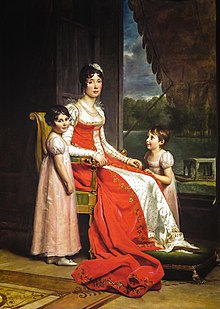Julie Clary
| Julie Clary | |||||
|---|---|---|---|---|---|
| Queen consort of Spain and the Indies Queen consort of Naples and Sicily Comtesse de Survilliers | |||||
 Julie Clary and her daughters | |||||
| Queen consort of Spain | |||||
| Tenure | 8 June 1808 – 11 December 1813 | ||||
| Queen consort of Naples and Sicily | |||||
| Tenure | 30 March 1806 - 6 June 1808 | ||||
| Spouse | Joseph Bonaparte | ||||
| Issue | Julie Joséphine Bonaparte Zénaïde Laetitia Julie Bonaparte (1801–1854) Charlotte Napoléone Bonaparte (1802–1839) | ||||
| |||||
| House | House of Bonaparte | ||||
| Father | François Clary | ||||
| Mother | Françoise Rose Somis | ||||
Marie Julie Bonaparte (née Clary; 26 December 1771, Marseille – 7 April 1845, Florence) was Queen consort of Spain and the Indies, Naples and Sicily as the spouse of King Joseph Bonaparte, who was King of Naples and Sicily from January 1806 to June 1808, and later King of Spain and the Spanish West Indies from 25 June 1808 to June 1813.
Background
Julie Clary was born in Marseille, France, the daughter of François Clary (Marseille, St. Ferreol, 24 February 1725 – Marseille, 20 January 1794), a wealthy silk manufacturer and merchant, and his second wife (married on 26 June 1759) Françoise Rose Somis (Marseille, St. Ferreol, 30 August 1737 – Paris, 28 January 1815).
Her sister Désirée Clary, six years younger than Julie, became Queen of Sweden and Norway (as Desideria) when her husband, Marshal Bernadotte, was crowned King Charles XIV John of Sweden (Charles III John of Norway). Her brother Nicholas Joseph Clary was created 1st Comte Clary and married Anne Jeanne Rouyer.
On 1 August 1794 at Cuges (Bouches-du-Rhône department) she married Joseph Bonaparte, elder brother of Napoléon Bonaparte, and later King of Naples and King of Spain.
Queen
In 1806, her spouse was made king of Naples, and Julie thereby became queen of Naples. In 1808, Joseph was made king in Spain and Julie was made Queen of Spain. However, she never lived there, preferring Mortefontaine, in the Oise department of France. She was kept informed from Vichy and Plombières about her husband's adulterous relationships with the Caribbean-Cuban born Dowager Countess of Jaruco, Teresa de Montalvo, and Maria del Pilar Acedo, Marquesa de Montehermoso.
After the fall of Napoleon
After the defeat of the French Napoleonic Army at the Battle of Vitoria, on 21 June 1813 and the entry of allied troops in Paris in 1814, Julie bought the castle of Prangins in Switzerland, near Lake Léman.
After the Battle of Waterloo and the downfall of Bonaparte, Joseph bought a property in the State of New York near the River Delaware, with the proceeds of the sale of Spanish paintings taken from ransacked Madrid palaces, castles, monasteries and town halls.
In 1816, her sister Desiree, who was Crown princess of Sweden, wished to bring her sister Julie with her upon her return to Sweden; her husband, however, thought this unwise, as Julie was a member of the Bonaparte family and her presence might be taken as a sign that he sided with the deposed Napoleon, and in the end, this came to nothing[1].
Later life

Julie went with her daughters to Frankfurt where she stayed for some six years, separated from her French-American husband. She later settled in Brussels and then in Florence, Italy, at the Serristori Palace. She did not socialize with the French people. She was described as charming, quiet, dignified and peaceful and generally well liked. During this period, she parted with her sister Desiree, who as the queen of Sweden moved to Sweden.
In 1840, Joseph joined Julie in Florence. In spite of his adultery, she referred to Joseph as "my beloved husband".
Joseph Bonaparte died in her arms on 28 July 1844 at the age of seventy-six. She died eight months later on 7 April 1845, at the age of seventy-three. They were buried side by side at the Basilica of Santa Croce in Florence. Seventeen years later, in 1862, the self-proclaimed French Emperor Napoleon III brought Joseph Bonaparte's remains back to France and had them inhumed to the right of his younger brother, the Emperor Napoleon I.
The remains of Julie are still at the Basilica of Santa Croce in Florence beside those of her daughter, Charlotte, who had died in Lucca, in Italy, on 3 March 1839, at the age of thirty-seven, when giving birth to a stillborn child.
Children
Joseph Bonaparte and Julie had three daughters:
- Julie Joséphine Bonaparte (1796-1796)
- Zénaïde Laetitia Julie Bonaparte (1801–1854) had twelve children
- Charlotte Napoléone Bonaparte (1802–1839), married in 1826 Napoléon Louis, eldest son of Louis Bonaparte, King of Holland, and Hortense de Beauharnais, widowed in 1830
References
- ^ Cecilia af Klercker (översättning och redigering) (1942). Hedvig Elisabeth Charlottas dagbok IX (The diaries of Hedwig Elizabeth Charlotte IX) (in Swedish). P.A. Norstedt & Söners förlag. ISBN 412070.
- Manuel Ríos Mazcarelle. Reinas de España, Casa de Borbón, I, Alderabán, El legado de la historia, Madrid, 1999. 1ª edición, ISBN 8488676573, 291 pages, (Spanish).
